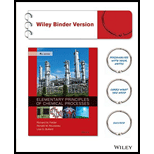
One g-mole of pure liquid sulfuric acid at temperature T0(°C) is mixed with r g-moles of liquid water, also at temperature T0(°C), in an adiabatic container. The final solution temperature is Ts(°C). The heat capacities of the pure acid, pure water, and the product solution [J/(g·°C)] are Cpk, Cpw, and Cps, respectively, all of which may be taken to be independent of temperature.
- Without doing any calculations, sketch the plot of Tsversus r you would expect to obtain for r varying between 0 and oo. (Hint: Think first about what you would expect Tsto be at the extreme values of r.) Use an energy balance to derive an expression for T sin terms of the initial acid and water temperatures, the heat capacities, the water/acid mole ratio (r), and the heat of mixing,
| r (mol H2O) | 0.5 | 1.0 | 1.5 | 2.0 | 3.0 | 4.0 | 5.0 | 10.0 | 25.0 | 50.0 | 100.0 |
| Cp[J/(g·°C)] | 1.58 | 1.85 | 1.89 | 1.94 | 2.10 | 2.27 | 2.43 | 3.03 | 3.56 | 3.84 | 4.00 |
The heat capacities of pure sulfuric acid and pure water may be determined from the molar heat capacities in Table B.2 evaluated at 25°C. All heat capacities should be taken to be independent of temperature.
Unfortunately, the laboratory air conditioner has been out of order for three weeks (Physical Plant promises they will get to it any day now) and the temperature on the July afternoon of the experiment (which also equals the initial acid and water temperatures) is an uncomfortable 40°C. Prepare a spreadsheet to generate a table and then a plot of Ts. the final temperature in each flask, versus r. the water/acid mole ratio of the solution in the flask. (Suggestion: Make the r axis logarithmic.) Assume that mixing is adiabatic.
Want to see the full answer?
Check out a sample textbook solution
Chapter 8 Solutions
Elementary Principles of Chemical Processes, Binder Ready Version
Additional Engineering Textbook Solutions
Elements of Chemical Reaction Engineering (5th Edition) (Prentice Hall International Series in the Physical and Chemical Engineering Sciences)
Process Dynamics and Control, 4e
Heating Ventilating and Air Conditioning: Analysis and Design
Starting Out with Python (4th Edition)
Engineering Mechanics: Statics
Manufacturing Engineering & Technology
 Introduction to Chemical Engineering Thermodynami...Chemical EngineeringISBN:9781259696527Author:J.M. Smith Termodinamica en ingenieria quimica, Hendrick C Van Ness, Michael Abbott, Mark SwihartPublisher:McGraw-Hill Education
Introduction to Chemical Engineering Thermodynami...Chemical EngineeringISBN:9781259696527Author:J.M. Smith Termodinamica en ingenieria quimica, Hendrick C Van Ness, Michael Abbott, Mark SwihartPublisher:McGraw-Hill Education Elementary Principles of Chemical Processes, Bind...Chemical EngineeringISBN:9781118431221Author:Richard M. Felder, Ronald W. Rousseau, Lisa G. BullardPublisher:WILEY
Elementary Principles of Chemical Processes, Bind...Chemical EngineeringISBN:9781118431221Author:Richard M. Felder, Ronald W. Rousseau, Lisa G. BullardPublisher:WILEY Elements of Chemical Reaction Engineering (5th Ed...Chemical EngineeringISBN:9780133887518Author:H. Scott FoglerPublisher:Prentice Hall
Elements of Chemical Reaction Engineering (5th Ed...Chemical EngineeringISBN:9780133887518Author:H. Scott FoglerPublisher:Prentice Hall
 Industrial Plastics: Theory and ApplicationsChemical EngineeringISBN:9781285061238Author:Lokensgard, ErikPublisher:Delmar Cengage Learning
Industrial Plastics: Theory and ApplicationsChemical EngineeringISBN:9781285061238Author:Lokensgard, ErikPublisher:Delmar Cengage Learning Unit Operations of Chemical EngineeringChemical EngineeringISBN:9780072848236Author:Warren McCabe, Julian C. Smith, Peter HarriottPublisher:McGraw-Hill Companies, The
Unit Operations of Chemical EngineeringChemical EngineeringISBN:9780072848236Author:Warren McCabe, Julian C. Smith, Peter HarriottPublisher:McGraw-Hill Companies, The





